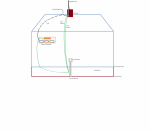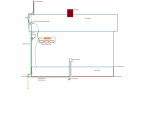Be careful what you read on QRZ. Like this website, it's often a lot of hobbyists and self proclaimed experts.
Much like here.

Masonry walls, whether they be concrete block (CMU), brick, or adobe, are strong in compression along the vertical axis. They aren't so strong when subjected to a side load. CMU walls for buildings must be carefully braced during construction so that they don't fall, especially in the face of strong winds. But, when the building's roof structure is applied and the wall is loaded in compression, the wall becomes stronger against side loads.
A brick chimney has no compression loading other than its own weight and it only needs to be strong enough to resist the side loading from the wind. That's why attaching a large antenna array to a chimney is generally a bad idea. The antenna and its mounting system increases the side loading and one strong wind will very likely result in your antenna and your chimney laying in the yard.
Once you get up on the roof, take a very close look at the chimney. If you see loose bricks or mortar that is cracked or eroded away, hire a brick mason to take a look at it.
While seismic reinforcements are common in some earthquake-prone parts of the world, they are virtually non-existent in others. Also, even if current building codes require seismic reinforcement, many older houses have none.



